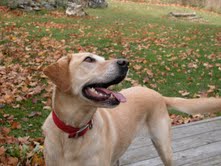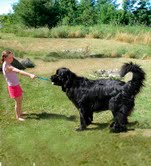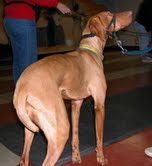Which wag?
One of the biggest misconceptions that we hear about dog body language is:
"The dog must be happy because he is wagging his tail."

Actually, a wagging tail is one of least reliable indicators of how a dog is feeling. There are many different types of tail wagging, but there is only one type of wag that indicates the dog is safe for children to pet—the calm wag.
The calm wag
The calm wag is a loosely wagging tail, with the tail held below the level of the dog's back. For breeds that naturally curl their tails over their backs, the tail will be held high, but the wag is loose.
The whole dog may wag to some degree, but it is not a frantic wag. The calm wag, accompanied by a smiling, panting face, indicates a relaxed dog that may want to meet or interact with a child. The best way to interact with the happy, panting, and wagging dog is to invite the dog over to see you rather than moving into the dog's space.
If the dog stops panting and wagging, or stops panting and commences a stiffer type of wagging, read the change as a warning to back off. In those circumstances, the dog has become uncomfortable with your approach.
This video demonstrates the difference between a high, stiff wag (discussed in detail below) and a calm wag. Notice that the white dog holds his tail very high and stiff while he is meeting and sizing up the other dogs, but when he interacts with the child he holds his tail lower and wags loosely. The dog is loose with the child and stiff with the other dogs. His interaction with the child is entirely appropriate; this is the type of wag you want to see in all dogs that interact with children. If you don't see the calm, loose wag, intervene and redirect the dog and child to other activities.
The propeller wag
In the propeller wag the entire tail goes all the way around like a propeller. This wag is usually reserved for greetings to special people, folks the dog is particularly happy to see. If you see the propeller wag, the dog wants to greet you. This is fine if you are an adult, but the level of excitement may be too much for a child. The dog may jump, scratch, or knock over a small child by mistake. Wait for the dog to calm down before allowing the dog to greet children.
The whole body wag
Sometimes a dog is so happy and excited that the whole dog wags in a frenzy of activity. Again, a dog this excited should not be allowed to interact with children until he is calm.
The high tail

If a dog holds his tail high over his back, either wagging stiffly or held still, it is a warning to back off. The dog is assessing the situation and is not likely to be welcoming of any invasion of his space. If your dog puts his tail up to you or your children, it could be a sign of impending trouble. The dog could be issuing a challenge (see photo) and may bite if provoked further.
Find a behavior consultant who will use positive reinforcement-based training to help your dog develop a more cooperative relationship with the family. Teach your children to "Be a Tree" immediately if a dog puts up his tail to them—even if the dog is their own or one they know.
The slow wag
The slow wag, if accompanied by a generally stiff body, is also a sign of danger. The dog is making a decision—and he may decide that he does not want to meet you.

The low wag
Sometimes a dog will hold his tail very low, or between his legs, or even wag just the end of his tail. This dog is feeling very uncertain, or even afraid, and would prefer to be left alone.
A wag and a smile
The movement of a dog's tail is an excellent clue about how the dog is feeling. The kind of tail-wagging a dog offers indicates the dog's level of openness to interaction with people, including children. Understanding the "language" of wags can increase the levels of comfort and safety in human/dog interactions.


